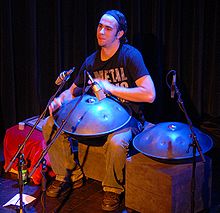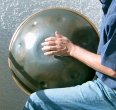What is that thing that sits on your lap, looks like a UFO shaped drum and sounds like a steel drum?

See video gallery
Hang (instrument) - Wikipedia, the free encyclopedia
The Hang (German pronunciation: [haŋ],[1] plural form: Hanghang) is a musical instrument in the idiophone class created by Felix Rohner and Sabina Schärer in Bern, Switzerland. The name of their company is PANArt Hangbau AG.[2] The Hang is sometimes referred to as a hang drum, but the inventors consider this a misnomer and strongly discourage its use.[3]
The instrument is constructed from two half-shells of deep drawn, nitrided steel sheet[4] glued together at the rim leaving the inside hollow and creating a distinct 'UFO shape'. The top ("Ding") side has a center 'note' hammered into it and seven or eight 'tone fields' hammered around the center. The bottom ("Gu") is a plain surface that has a rolled hole in the center with a tuned note that can be created when the rim is struck.
The Hang uses some of the same basic physical principles as a steelpan, but modified in such a way as to act as a Helmholtz resonator.[5][6]The creation of the Hang was the result of many years of research on the steelpan and other instruments.[7]The inventors of the Hang have continued to refine the shape and materials and have produced several variations over the years.
The name Hang comes from the Bernese German word for hand. It is a registered trademark and property of PANArt Hangbau AG.[8]
Contents[hide] |
[edit]Playing the Hang
The Hang is typically played resting on the player's lap. The Hang is generally played with the hands and fingers instead of mallets. This lighter means of playing produces an overtone-rich sound that could be considered 'softer' and 'warmer' than the 'bright' sound of a mallet based traditionalsteelpan.
The top (Ding) side of the Hang, depending on how it is played, can sound like a harp, bells, or harmonically tuned steelpans. The notes are laid out in a cross pattern in the 'tone circle' from low to high so that with a specific orientation of the Hang, the player can ascend or descend the 'scale' by alternating using the left and right hands to strike the 'tone fields'. Each tone field has multiple overtones oriented specifically in the flattened field with a dome at the center. Typically there is a fundamental tone, an overtone tuned to an octave above that fundamental, and an additional overtone a fifth above that octave (twelfth/tritave). The orientation is fairly consistent across the fields on each Hang so that the overtones can be highlighted, muted, or extracted based on how and where the player strikes the tone field.
The bottom side of the Hang has a round opening, the Gu, producing together with the air in the cavity a Helmholtz resonance similar to a ghatamor an udu. In the 2nd Generation, Integral Hang and Free Integral Hang adjustment of the size of the Gu (by partially blocking it with either a hand, or the legs) can generate a sympathetic D2 from the Helmholtz resonance, which introduces subtle layers of cross complexities in the resonance of the instrument as notes are played on the Ding side. In the 1st and 2nd Generation models there is a single high note with a long sustain that can be generated by striking the rim of the hole on the 'Gu' side. In the Integral Hang there are two notes that can be generated (F and F#). The Hang can also be used as a friction idiophone. Shaker like sounds can be made by sliding a hand across the surface, and it can also ring like asinging bowl by using skin (a hand) or a bow.
[edit]Sound examples
 |  |
[edit]Creation and development
The Hang was developed in the year 2000 and introduced at the Musikmesse Frankfurt in 2001. It is 52 cm in diameter and has a height of 24 cm. The two deep drawn steel hemispheres of the Hang are hardened by a process known as gas-nitriding. The side considered the 'bottom' has an opening (Gu) in the center which allows the generation of the bass note through Helmholtz resonance. When it is played in a damped way it can change in pitch similar to a talking drum. On the 'top' are seven or eight notes arranged in a tone circle in zig-zag fashion from low to high. All are tuned harmonically (with fundamental, octave and the fifth above the octave) around a low note (Ding) at the center of the tone circle. Each creation is numbered and signed.[9]
There are only two people who build Hanghang, the inventors Felix Rohner and Sabina Schärer. They have a little workshop in Bern where every Hang has been created.
[edit]First Generation
From 2001 to 2005 the first generation Hang was offered in multiple scales ranging up to 45 different 'sound models'. The Hang makers took their initial inspiration from ethnomusicological roots with models such as the Aeolian, Ake Bono, Hijaz, Melog, Pygmy, and Zhi Diao. From 2001 to 2004 each Hang had eight tone fields in the circle. In 2005 PANArt was able to lower the tones on the Hang significantly in what they referred to as the Low Hang with the Ding tuned to F3, E3 or Eb3. It was offered in two versions with eight or seven tone fields in the circle. In the First Generation each creation was numbered, the name of the sound model was written, and a signature of either Felix Rohner or Sabina Schärer was on a small note pasted on the inside of the top (Ding) surface.
[edit]Second Generation
In the spring of 2006 the Hang makers presented a new generation of Hang. The New Generation instruments (often referred to as 2nd generation) have a surface coating of annealed brass over the nitrided steel as well as a ring of brass around the circumference of the Hang. From the many different scales the Hang makers reduced to a structure with one type of central note (Ding) at D3. All New Generation models have two A notes (A3 and A4) as well as another D (D4) in the tone circle around the Ding.[10] The remaining notes were mixed into several different configurations. The majority of 2nd Generation Hanghang were built with seven tone fields in the circle. Older Hanghang had tone fields with the oval indentation oriented radially towards the Ding, with the 2007 models (as well as the Integral Hang) the tone fields are angled at about 45° from a line drawn from the Ding to the edge. They also started marking the individual serial number on the inside of the Gu opening and signing each Hang at the outside edge of the Gu side of the Hang. No sound model names were officially given to the 2nd Generation models.
[edit]Integral Hang
In the spring of 2008 the Hang makers announced a new version, the Integral Hang. Numbers began again with an H in front (H1, H2, etc.) and with the first Integral Hang dated in November 2007. Several changes marked the Integral Hang. There was only one scale with seven tone fields in the cycle (D3 Ding, A3, Bb3, C4, D4, E4, F4, A4) and no other sound models offered. While the circumference remained a circle, the Gu side was shaped very slightly from spherical to oval. Along with that shift, the Gu hole was adjusted to a subtly oval shape and had two Gu ringing 'notes': F and an F#. Significant changes were made to the Ding (center note on the top). A circular indentation in the dome was made and has a texture of brass applied, annealed, and then lacquered. Also changes to the 'shoulder' area between the flattened area of the Ding and the notes in the tone circle were implemented so that the transition was more gradual than in the 2nd generation Hanghang. The PANArt logo, serial number, date of finalization, and signatures of the Hang makers were placed on Gu side of the Hang near the equator where the two shells meet.
By developing the Integral Hang, Rohner and Schärer distanced themselves from the idea of building an instrument for the needs of professional musicians.[11] Their aims and ambitions were published in a 'Letter from the Hangbauhaus': "Our concepts, developments and implementations are far from the musical norms of modern times which require study, practice and performance. Playing with this Hang can lead to a form of freedom, an intimate conversation that can only unfold without pressure and coercion. If individuals are aware of this concept, they will be strengthened by this Hang. Thoughtless use can weaken a person."[3]


No comments:
Post a Comment